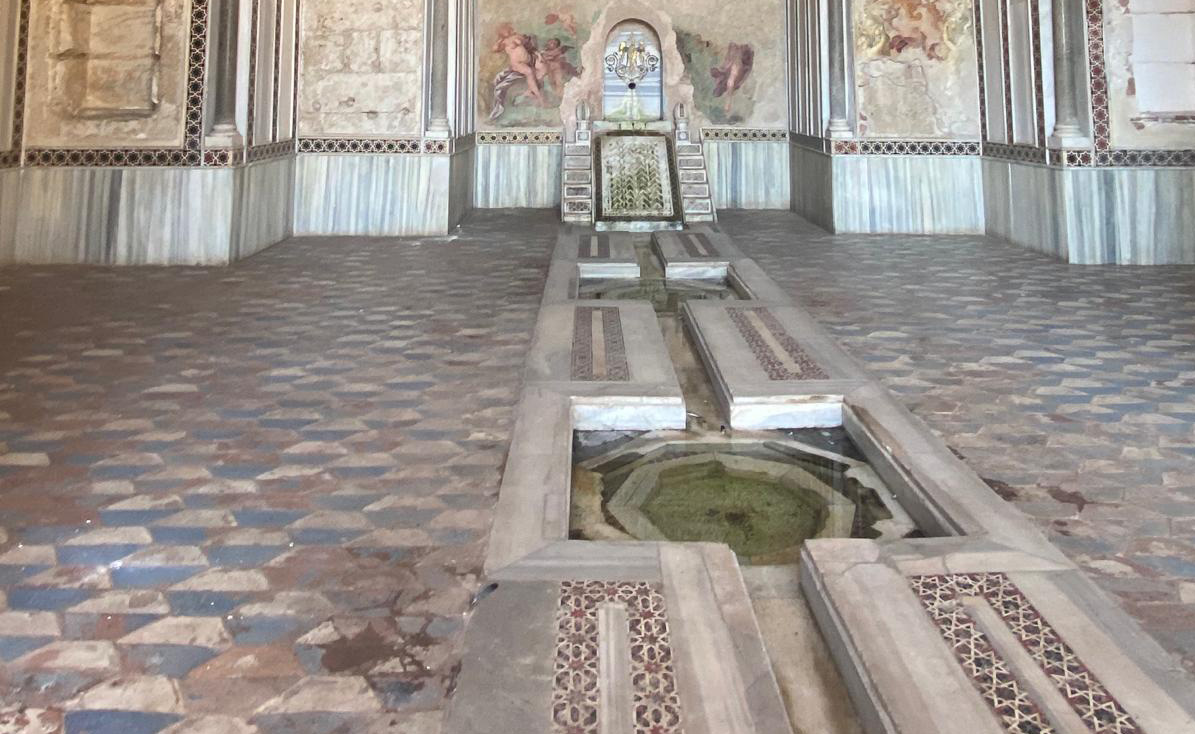Sultan Qalawun Maristan
1285 AD / EGYPT
Built in 1285 AD (684 Hijra) under the patronage of Sultan al-Mansur Qalawun at the beginning of the Bahri period (1280-1382) of the Mameluke dynasty that ended with the Ottomans in 1517, this architectural compound is a sign of prestige, power, and philanthropy, while it also starts a new era of integrating different edifices into a ‘complex’ that comprises a mausoleum for the sultan and his family, a madrasa (school) with four iwans and dormitories for students, and a large maristan accommodating up to 4,000 men and women patients, including those with mental turbulence. In 1915, a large part of the maristan was replaced by an ophthalmology hospital that is in operation today (2024). The remaining parts of the maristan were partially restored in the early 2000s to show where the water basin was located around individual rooms as well as where the women’s section was located some centuries ago.
Architectural Floorplans
The MWNF floorplan on the left provides a detailed rendition of the full complex, clearly depicting the massive size of the maristan. The display diagram on the right shows how much of the maristan was replaced by the modern ophthalmology hospital and the pieces that remain to be restored.


Historical Anecdote
Different sources tell the brief story of Qalawun falling ill during a campaign, as a captain with his army in Syria. He was taken to the famous Nour al-Din maristan in Damascus where he was treated for free and recovered from this illness. “On recovery, Qalawun vowed that he would build a great hospital in Cairo if he ever sat on the throne. At the dedication ceremony, he asked for a cup of wine from the well-stocked pharmacy shop at the hospital. After drinking it, he declared that by taking this potion as a medication he was signifying that this hospital was dedicated to serve all who needed medical care – from the king on the throne to the least among his subjects, whether rich or poor, young or old, male of female.” (Hamarneh, p.374) Apart from the unexpected wine commemoration anecdote, the positive influence of having been treated at the Nour al-Din maristan is indicative of the borrowing of good practices when coming to power: the philanthropy of a leader would show their benevolence towards their community while also transferring architectural designs and scientific knowledge from neighboring geographic areas.
Maristan Window
Water Fountain
An unexpected civilization osmosis connection, as described by the MWNF: “little remains of the hospital today but for a few ruined parts, such as a section of the eastern iwan consisting of a marble fountain and a shadriwan (wall fountain), which once had fine marble decoration that resembled that in al-Aziz Palace (Zisa) in Palermo, Sicily, the construction of which was completed between AH 561 and 570 / AD 1166 and 1175.” Completed prior to the Qalawun complex, it may be that the renown of the Zisa Palace reached Cairo with some of the architects.

Image Gallery
Travel Blog
Cairo 2, Egypt
Next to another imposing city gate called Bab Zuweila, Ibrahim the caretaker is washing the steps of the Sultan al-Muayyad Shaykh Mosque with a squeegee mop...Cairo 1, Egypt
If it were raining, you could be entering a scene from Blade Runner with the darkness of night pierced by bright neon lights of billboards. But...References
Sami Hamarneh, “Development of Hospitals in Islam”, Oxford University Press: Journal of the History of Medicine and Allied Sciences, Vol. 17, No. 3 (July 1962), pp. 366-384.
Doris Behrens-Abouseif, Islamic Architecture in Cairo, An Introduction. Cairo: American University Press, 1989.
Sharif Kaf Al-Ghazal, “The Origin of Bimaristans (Hospitals) in Islamic Medical History”, Foundation for Science Technology and Civilization (FSTC), April 2007.